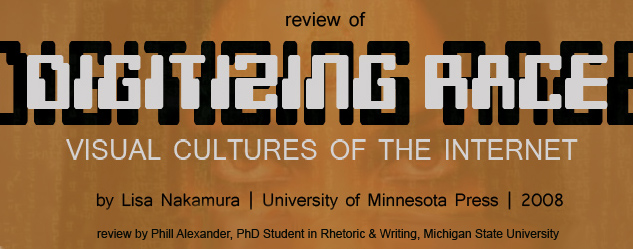

Introduction:
Digital Racial Formations
Chapter 1:
"Ramadan is Almoast Here"
Chapter 2:
Alllooksame
Chapter 3:
The Social Optics of Race
Chapter 4:
Avatars and Visual Culture
Chapter 5:
Measuring Race on the Internet
Epilogue:
Racio-Visual Logic
Conclusions on Digitizing Race
The proper relationship to the interface is codified quite clearly: competency and mastery is defined by the level of immediacy the user experiences in relation to it. (p. 95) In chapter 3 Nakamura utilizes the popular films of The Matrix trilogy and Minority Report to discuss the racialization (and genderedness) of the representation of computer interfaces. Early on she claims that these films: racialize digital access and production by depicting scenes of white and male users experiencing "direct" or immediate relations with computer interfaces, while users of color are relegated to the background, depicted with truncated and relatively distant, highly technologically mediated relationships to their hardware and software. (p. 96) The comparisons Nakamura makes, and the way these film depictions mirror the problems that other scholarship investigates (issues of access, the fact that the Internet is often presumed to be white and male, the fact that gaming is considered a white and male practice, the idea that interfaces are white hegemony), set up a fascinating reflection. There are times when questions might arise for the reader, such as what it might mean that Morpheus—an African American character—initially has far more immediacy and mastery over the Matrix than anyone else. The overwhelming imagery in the films builds on exactly the theme that Nakamura isolates. White privilege drives the representations of technology users, and anyone who isn’t white (and often isn’t male and white) is relegated to using older, less sophisticated technology. Chapter 3 also includes reflection on the familiar iPod advertisements such as the one below.
Nakamura argues that while the black silhouette of the person in the iPod ad allows the viewer to freely interject himself (or herself), this presentation is a “white” presentation of technology (the iPod is white), but also a use of racialized blackness to represent "cool" or "hip" in a way that white cannot (a contrast she draws from The Matrix and the comparison between the white Agent Smith and the black Morpheus). Across the two films and the iPod advertising campaign Nakamura tracks how black bodies do the things that white bodies can’t (or won't). This can be viewed both as a commentary on how race operates as a counterargument to the once utopian view of the Internet and as a commentary on what traits are commonly codified as belonging to what races. Applied to other media, the critical lens Nakamura forms while critiquing these three pieces could add considerably to current rhetorical understandings of how race is mobilized and codified in networked spaces.
|
